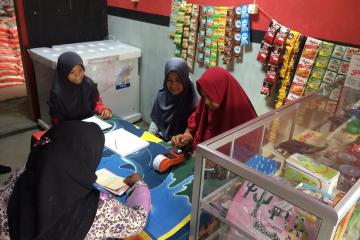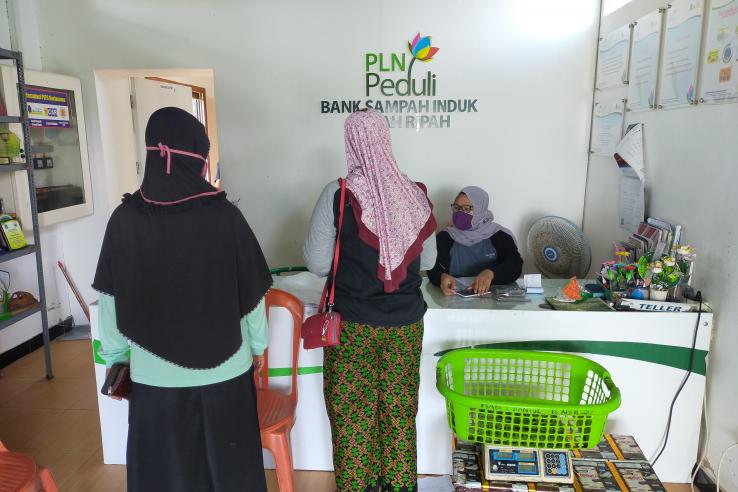
IFII Blog Series: Advancing inclusive digital financial services to empower women in Indonesia

Read this post in Bahasa Indonesia.
Financial services can give women more control over financial decisions, which can lead to empowerment and improved well-being. As women pursue well-being, they may identify financial needs and look for suitable financial products. When designed properly, access to financial services may not only help women build resilience and take advantage of opportunities, but it can also help them set goals and make decisions.
Improving the design and access to digital financial services is a key priority of the Inclusive Financial Innovation Initiative (IFII), established at J-PAL Southeast Asia to generate and promote evidence in the DFS sector. As part of IFII’s commitment to spark conversation about gender in financial inclusion, IFII is launching a blog series to explore questions about DFS inclusion for women. This first blog in the series summarizes learnings from the IFII Learning Collaborative Forum in Women’s Economic Empowerment and Financial Inclusion held on May 27, 2021 and attended by organizations working to advance financial inclusion for women.
Digital financial services (DFS) as a tool to increase women’s empowerment
The Learning Collaborative forum began by reviewing existing evidence on the link between women’s access to financial services and empowerment and the Indonesian financial services landscape.
Among other factors that may limit women’s financial services adoption, unequal gender roles may create time and mobility constraints, which ultimately can become barriers in accessing financial services. There is scope for DFS to ease some of these constraints. For example, at the household level, previous evidence suggests DFS may help women gain easier, more secure, and less costly access to financial services. DFS might also provide women with more privacy and control over their finances, which may improve women’s agency in exercising their preferences.
In Indonesia, there is no gender gap in formal account ownership: 61.6 percent of women and 61.7 percent of men have an account according to the 2020 SNKI Financial Inclusion Insights (FII) survey. However, based on our further analysis of the FII 2020 data, there is evidence that men are better positioned to adopt DFS.
While 56 percent of men are digitally ready—that is, they own a smartphone and can use it to download apps and surf the web—only 50 percent of women are equally ready. As DFS continues to expand in Indonesia, it is important to try and close this gap so that the rest of women can also benefit. Moreover, there are several aspects to consider when designing DFS that can enable women’s empowerment.
Contextual and needs-based design is key to increase adoption and benefits
During the forum we also reviewed evidence from several randomized evaluations, which suggests context can play an important role in determining how financial services impact women’s lives. A re-analysis of evaluations in India, Ghana, and Sri Lanka, found that women benefited more from access to grants and microcredit when they were the sole business owners in the household. In Uganda, digitizing microfinance loan disbursement to female borrowers helped increase business profits by 15 percent. The gains were larger for women who experienced pressure to share money with their spouse. However, in the Philippines, transitioning women’s microfinance groups to digital loan disbursement decreased household savings and increased reliance on informal loans. In this setting, there is some evidence of weakened cohesion among loan groups, suggesting that DFS could weaken social capital that is important for women’s economic activity.
Evidence from these studies suggest that careful design that pays attention to unique needs and social context are important elements to further advancing the benefits of DFS to women. When designing products, it is therefore essential to identify a target audience (e.g. female small business owners) and conduct a needs assessment to understand what design features are most important for that audience.
A woman’s source of income and financial priorities may influence the type of financial services needed
During the forum, participants were assigned to smaller groups, which discussed the needs, design solutions, and open questions that may be important to advancing the benefits of DFS to women. The discussions were based on three identified Indonesian women personas: female small business owners, unbanked housewives and female seasonal/informal workers.
These are some of the insights from our discussions:
In many cases, Indonesian housewives who are not involved in income-generating activities are responsible for managing their husband’s earnings for both daily and long-term needs such as children’s education, healthcare needs, and insurance against shocks. One way to increase access to and adoption of DFS is to design products for household financial management, while at the same time ensuring users understand why and how to use DFS to meet household financial goals.
Women involved in income-generating activities, such as entrepreneurs, tend to allocate a portion of their business income for household consumption. DFS that enables financial management for both household and business needs can facilitate this.
In the case of women who work as seasonal/informal workers, they usually have immediate financial needs for their families back home, since the majority of these women are migrants from rural areas. DFS can help them access and control their financial resources at any place and any time. Furthermore, transitioning from cash to digital wage payments will facilitate their use of DFS for savings and transactions.
Targeted digital financial education and products designed for women
Although there are different financial needs across women with different roles, low financial literacy and capacity, as well as low digital readiness, remain some of the most common constraints for rural, lower-income women in adopting DFS. This indicates the need for a full-range digital financial education, and for DFS to have features that can be easily understood by women facing these barriers.
Open questions remain on how to advance the use of DFS to empower unbanked rural women:
- How can service providers improve access to and knowledge of DFS for women?
- How can service providers design DFS that are customized for previously unbanked women or tailored to women’s needs?
- What kind of DFS features can allow women to increase their digital capabilities?
- How can we better utilize existing institutions in the community to help women adopt DFS?
- Can DFS shift gender norms within and outside the household?
- How can we help financial service providers measure the impact of their products on women’s empowerment?
IFII aims to ensure that DFS drives economic development while lifting up marginalized populations, including women and people living in poverty. The IFII Learning Collaborative Forum helps J-PAL and other relevant stakeholders in this sector to learn together from evidence, share policy lessons, discuss open questions and brainstorm ideas to advance women’s economic empowerment through financial inclusion. To get involved, reach out to [email protected]
Read the second blog in the series (English) (Bahasa Indonesia).
Related Content

Improving women’s digital literacy as an avenue for financial inclusion

Strengthening Indonesia’s branchless banking agent network: Challenges and lessons from evidence

